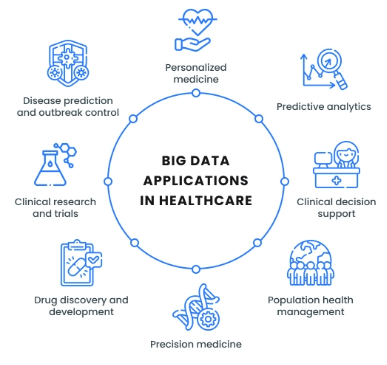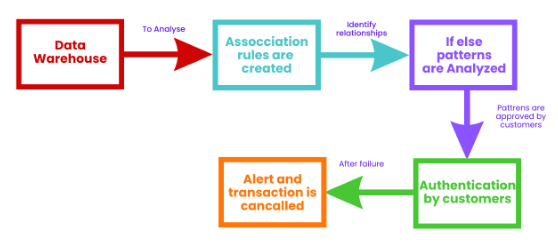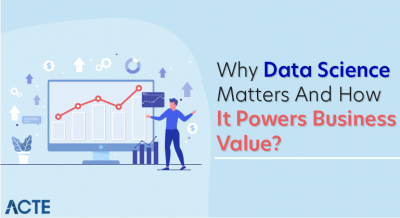
- Introduction to Big Data Applications
- Healthcare: Predictive and Personalized Medicine
- Retail: Customer Behavior Analytics
- Finance: Fraud Detection
- Manufacturing: Predictive Maintenance
- Transportation: Route Optimization
- Media: Recommendation Engines
- Education: Personalized Learning
Introduction to Big Data Applications
In today’s digital era, Big Data has become one of the most transformative technologies influencing industries and societies globally. Big Data refers to extremely large and complex datasets that traditional data processing tools cannot efficiently handle. The true value of Big Data lies in the insights extracted from analyzing this vast information. These insights uncover hidden patterns, correlations, and trends that were previously unknown, enabling better decision-making and strategic planning. Big Data analytics is driving innovation across a wide range of sectors. In healthcare, it helps improve patient outcomes by enabling personalized medicine and predicting disease outbreaks. The retail industry leverages Big Data to understand consumer behavior, optimize inventory, and personalize marketing campaigns, highlighting the importance of Data Science Training for professionals in this field. Financial institutions use it to detect fraud, manage risk, and tailor investment strategies. Transportation companies analyze traffic patterns and optimize routes, reducing costs and environmental impact. Beyond these areas, Big Data supports advancements in agriculture by monitoring crop health and improving yields. Smart cities rely on Big Data to manage resources efficiently, improve public safety, and enhance urban living. Governments use Big Data to develop policies, respond to emergencies, and improve public services. This article highlights ten prominent real-world examples where Big Data has had a significant impact. These cases demonstrate how analyzing massive datasets can lead to innovation, efficiency, and competitive advantage. As technology continues to advance, Big Data’s potential will grow even further, transforming how organizations operate and how society functions.
Do You Want to Learn More About Data Science? Get Info From Our Data Science Course Training Today!
Healthcare: Predictive and Personalized Medicine
Healthcare is one of the most important sectors benefiting from Big Data applications. Every day, the healthcare industry generates vast amounts of data from sources like electronic health records (EHRs), medical imaging, genomic sequencing, and wearable devices that track patient health. This enormous volume of information provides new opportunities to improve patient care and operational efficiency. Predictive medicine uses Big Data to forecast patient outcomes and disease progression. Machine learning algorithms analyze historical health records alongside real-time data to predict the likelihood of chronic disease flare-ups or hospital readmissions, creating numerous Python Career Opportunities in healthcare analytics. This enables healthcare providers to take proactive measures, improving patient outcomes and reducing costs by preventing complications. Personalized medicine is another major advancement driven by Big Data. By combining genetic information with lifestyle and environmental factors, treatments can be tailored specifically to individual patients. This improves the effectiveness of therapies and minimizes side effects. For example, many cancer treatments now rely on genetic profiling to create customized treatment plans that target tumors more precisely. Big Data also plays a crucial role in public health by enabling epidemic tracking and disease surveillance.

By analyzing data from social media, travel patterns, and healthcare reports, officials can predict disease outbreaks and allocate resources more efficiently. The COVID-19 pandemic demonstrated how valuable these analytics are for identifying hotspots and managing healthcare capacity. Operationally, hospitals use Big Data to optimize staff scheduling, patient flow, and inventory management of medical supplies. This leads to improved service delivery, reduced wait times, and better overall patient care.
Retail: Customer Behavior Analytics
- Customer Segmentation: Retailers use data analytics to divide customers into distinct groups based on buying habits, preferences, and demographics. This helps target marketing efforts more effectively.
- Personalized Marketing: By analyzing past purchases and browsing history, retailers create personalized offers and recommendations that increase customer engagement and sales.
- Purchase Pattern Analysis: Retailers study how often customers buy specific products and at what times, enabling better inventory planning and promotions by leveraging Top Data Science Programming Languages.
- Churn Prediction: Analytics identify customers at risk of stopping purchases. Retailers then use targeted campaigns to retain these customers and reduce churn rates.
- Customer Journey Mapping: Data helps track how customers move through online or physical stores, revealing pain points and opportunities to improve the shopping experience.
- Sentiment Analysis: Retailers analyze customer reviews, feedback, and social media posts to understand customer satisfaction and identify areas for product or service improvement.
- Loyalty Program Optimization: Analytics assess the effectiveness of loyalty programs by measuring participation, reward redemption, and impact on repeat purchases, helping retailers refine these programs for maximum benefit.
- Transaction Monitoring: Financial institutions use data analytics to monitor transactions in real-time, identifying unusual patterns that may indicate fraudulent activity.
- Anomaly Detection: Advanced machine learning models detect deviations from normal customer behavior, flagging potential fraud for further investigation.
- Credit Risk Assessment: Analytics help evaluate the creditworthiness of borrowers by analyzing financial history, income, and other relevant data to minimize default risk, emphasizing the value of Data Science Training.
- Fraud Prevention Models: Predictive models are built to anticipate fraud attempts before they occur, allowing banks to implement preventive measures proactively.
- Behavioral Biometrics: Institutions use behavioral data, such as typing patterns or device usage, to authenticate users and detect imposters attempting fraud.
- Regulatory Compliance: Analytics ensure that financial organizations comply with regulations by monitoring transactions and reporting suspicious activities to authorities.
- Stress Testing and Scenario Analysis: Risk managers simulate different financial scenarios to assess potential impacts on portfolios, helping organizations prepare for market volatility and economic downturns.
- Route Planning: Data analytics helps transportation companies design the most efficient routes, minimizing travel time and fuel consumption while meeting delivery deadlines.
- Real-Time Traffic Monitoring: Using live traffic data, fleet managers can adjust routes on the fly to avoid congestion, accidents, or road closures, improving punctuality.
- Fuel Efficiency: Analytics track vehicle fuel usage and driver behavior to identify ways to reduce consumption, lowering operational costs and environmental impact.
- Predictive Maintenance: Sensors on vehicles collect data to forecast maintenance needs before breakdowns occur, reducing downtime and repair expenses, which are Reasons You Should Learn R, Python, & Hadoop.
- Driver Performance Monitoring: Fleet managers analyze driver habits like speed, braking, and idling to promote safer and more efficient driving practices.
- Load Optimization: Data helps maximize vehicle capacity by optimizing cargo distribution, reducing the number of trips needed and enhancing overall efficiency.
- Fleet Utilization: Analytics provide insights into fleet usage patterns, helping companies allocate resources better and decide when to expand or retire vehicles.
Would You Like to Know More About Data Science? Sign Up For Our Data Science Course Training Now!
Finance: Fraud Detection and Risk Management

Manufacturing: Predictive Maintenance and Quality Control
In manufacturing, Big Data combined with the Industrial Internet of Things (IIoT) is transforming production processes and maintenance strategies. Modern factories are equipped with sensors embedded in machinery that continuously collect data on parameters such as temperature, vibration, and pressure in real time. This constant flow of information provides a rich source of data for analysis. Predictive analytics plays a crucial role in processing sensor data to forecast equipment failures before they happen. By identifying early warning signs of potential breakdowns, manufacturers can schedule maintenance proactively, avoiding costly downtime and unplanned repairs showcasing A Day in the Life of a Data Scientist. This predictive maintenance approach not only reduces operational costs but also extends the lifespan of machinery. Quality control also benefits significantly from Big Data analytics. Pattern recognition algorithms analyze data from production lines to detect defects early in the manufacturing process. Early detection ensures that only products meeting quality standards reach customers, reducing waste and improving brand reputation. Furthermore, Big Data supports supply chain optimization by enabling manufacturers to forecast demand more accurately, manage inventory efficiently, and evaluate supplier performance. By leveraging data-driven insights, companies can minimize inventory costs, prevent stockouts, and maintain smooth operations. Overall, the integration of Big Data and IIoT empowers manufacturers to improve productivity, reduce costs, and maintain a competitive edge in a rapidly evolving market. This data-driven approach is becoming essential for manufacturing organizations aiming to innovate and succeed in the digital age.
Are You Considering Pursuing a Master’s Degree in Data Science? Enroll in the Data Science Masters Course Today!
Transportation: Route Optimization and Fleet Management
Media: Content Personalization and User Engagement
Media companies increasingly rely on Big Data to personalize content and boost user engagement. By tracking user behavior, such as clicks, views, watch time, and sharing patterns, these platforms gather valuable insights into audience preferences. This data allows them to create highly personalized recommendations that keep viewers engaged for longer periods. Streaming giants like Netflix and YouTube are well-known examples that use advanced algorithms to analyze viewing habits and suggest content tailored to individual tastes, enhancing user retention and satisfaction. Beyond personalization, Big Data informs content creation strategies. By analyzing trending topics, social media discussions, and audience demographics, media producers can develop shows, articles, music, or videos that resonate more strongly with their target audience, using techniques like What is Normality Test in Minitab. This data-driven approach helps companies stay relevant and competitive by delivering content that aligns with current interests and cultural trends. Targeted advertising is another key area where Big Data plays a crucial role. Media companies use user data to serve highly relevant ads, improving the chances of conversion and increasing advertising revenue. Advertisers benefit from better targeting while users receive ads that are more aligned with their preferences, creating a more effective and less intrusive advertising experience. Overall, Big Data enables media companies to build a more engaging and profitable ecosystem. By leveraging detailed user insights, these organizations can improve content relevance, optimize monetization strategies, and foster deeper connections with their audiences in an increasingly crowded media landscape.
Want to Learn About Data Science? Explore Our Data Science Interview Questions & Answer Featuring the Most Frequently Asked Questions in Job Interviews.
Education: Adaptive Learning and Student Success
Education is increasingly integrating Big Data to enhance learning outcomes and improve institutional efficiency. Learning analytics play a vital role by tracking various student metrics such as engagement levels, test scores, and learning preferences. By analyzing this data, educators can identify individual strengths and weaknesses, allowing for more targeted support and interventions tailored to each learner’s needs. Adaptive learning platforms use Big Data to customize lesson plans and adjust the pace of instruction based on real-time student performance. This personalization helps students grasp concepts more effectively and stay motivated throughout their educational journey. These platforms can accommodate different learning styles, ensuring a more inclusive and engaging experience for all students, which is a key benefit of Data Science Training. Early warning systems leverage attendance records and performance data to detect students who may be at risk of dropping out or falling behind. By identifying these students early, schools and educators can provide timely assistance, such as tutoring or counseling, improving retention rates and overall academic success. Big Data also supports curriculum development by analyzing aggregated data trends across schools or districts. This insight helps educators optimize teaching methods, align content with student needs, and respond to emerging educational challenges. It enables a more evidence-based approach to education policy and planning. Overall, the use of Big Data in education fosters a more personalized, inclusive, and effective learning environment. By harnessing data-driven insights, educational institutions can better support students, improve teaching quality, and prepare learners for success in a rapidly changing world.





